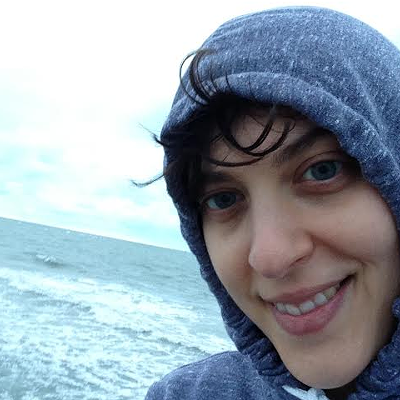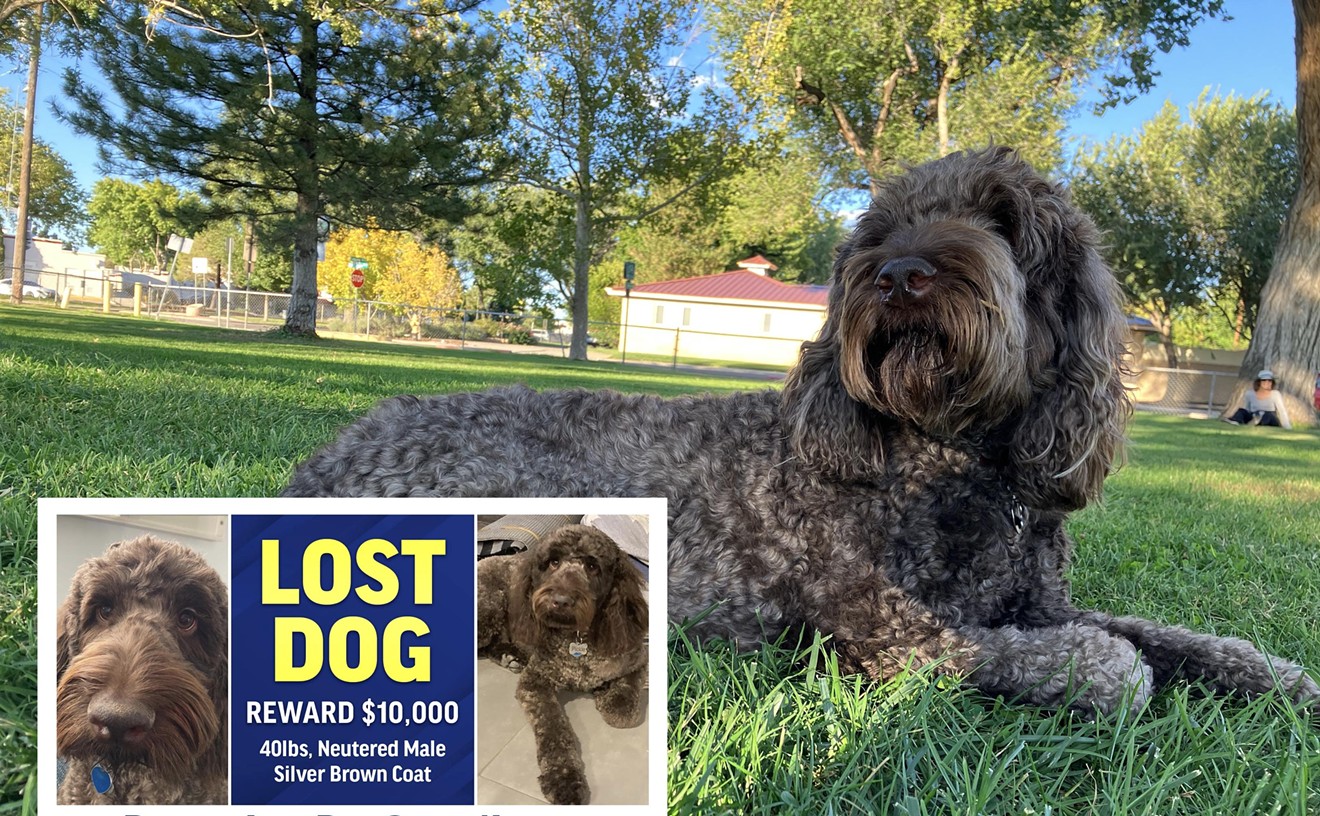For nine months, it hung in her spare bedroom: the dress she had planned to wear on her wedding day. It was long and white, like a wedding dress should be, and it was overlaid with intricate lace. Delicate chiffon flowers and silver beading accented the straps and cascaded down the front, while the back of the gown ended in a short, stylish train that Jen Berman imagined would trail behind her as she walked toward her fiancé, Doug Furcht. Choosing her dress was the one part of the wedding planning she'd accomplished, and it symbolized the hope she and Doug shared that he'd live to see the day when the two would be married.
Around the time she went for her fitting, in June 2013, Jen was busy preparing her house so that Doug could move in with her. It was going to take some work: In May, Doug had suffered a stroke that doctors believed was triggered by the radiation treatments he underwent for the brain cancer he'd been fighting for years. The stroke had robbed him of the use of his left arm and leg, and though he was working to regain it, he couldn't yet walk without help. The plan was to relocate the master bedroom of her historic 1886 Capitol Hill carriage home from the second floor to the first floor to make it easier for him.
But in July, Doug had a seizure. He'd had them before, but this one was different. This time he didn't wake up. Further testing revealed that the infection that had plagued him since his last surgery was back, and it was spreading to other parts of his body. With few medical remedies left, Jen, along with Doug's family, made the decision to untether him from the machines that were keeping him alive. He passed away two hours later.
Although she knew by that point that Doug's illness was terminal, Jen was devastated. "For months and months, so much of my life had been taking care of him and helping him figure out how to take care of himself and get through this," she says. Without him, "I really didn't know what to do with myself."
Over the next weeks and months, Jen endured the physical pain of losing her soulmate: the nausea, the heartache, the simultaneous exhaustion and sleeplessness. She worked through her overwhelming loneliness — and the guilt she felt whenever she allowed herself to go out with friends and have a good time. She visited a grief counselor and attended a widows' group. But the dress stayed where it was, shrouded in a white garment bag in the spare bedroom, where she'd hung it.
It stayed there as she slowly began to shed her crippling sadness. Or as she puts it, to become unstuck. It stayed there until she was finally ready to let it go.
*************
Jen and Doug met at a dodgeball game at the Denver Athletic Club in the fall of 2008. Jen was a 31-year-old Minnesota native living in Denver who worked as an attorney in the criminal-appeals division of the Colorado Attorney General's Office. Doug, who was raised in Colorado, was a 37-year-old software engineer who worked for a company called NewsGator, which developed communication products for businesses.
Jen had played in a dodgeball league before with friends, but that year she had signed up solo because none of her friends wanted to play another season. Daunted by the prospect of not knowing anyone, she almost talked herself out of going to the first game. But her determination won out, and she showed up knowing just one thing about her team: They were supposed to wear green. When she got to the DAC, she scanned the room for a minute before noticing a guy walk in. He was thin and athletic, with wavy brown hair. He seemed confident, and he was wearing green, too.
"I thought to myself, 'I hope he's on my team,'" Jen says.
Jen and Doug's first official date was a few months later, when they made plans to go Christmas shopping at the Cherry Creek mall. "It was very relaxed, which was nice," Jen says. "We just walked around and made silly comments...[and] hung out in Williams-Sonoma and went to this Indian restaurant that I don't even think is there anymore.... It was a good way to get to know each other."
That date led to others: a stroll through the First Friday Art Walk on Santa Fe Drive; a trip to an Ethiopian restaurant where they ordered way too much food; breakfasts at Perkins and happy hours at Charlie Brown's. Doug was an avid cyclist, and the two started going on long, meandering bike rides through Denver neighborhoods. Oftentimes, they'd stop at a park along the way to sit on the swings. Doug tried to teach Jen to play ultimate frisbee, a sport he'd picked up in college and played competitively afterward. They played tennis, went hiking and did crossword puzzles together.
Doug told her that he'd noticed her that first day at dodgeball, too. Although their team had lost, Jen had been the last player standing. Doug had admired her pluck.
"Doug just sort of has a love for all things fun," Jen says. He loved competition and used to joke that if there was a winner and a loser, he was in. But whether he won or lost, she says, he was always good-natured about it. Jen liked that he was logical in situations where she tended to be emotional and that he challenged her to try new things.
And she admired his quirkiness. Doug had a language all his own, one that once inspired his co-workers to compile a "Dougtionary." Instead of saying "Damn it!" he'd use the French "Zut alors!" Movies were "picture shows," and if he wanted time to think about something, he'd say, "Let me noodle on it." He even extended his unique vocabulary to his cancer treatments. Chemo was "the sauce," radiation was "the ray gun," MRIs were "the tube," and the appointments where he'd hear the results were "the results show."
Doug told Jen about his health issues early in their relationship. In the fall of 2006, two years before they met, he'd had a seizure and ended up at Denver Health. He was taken there by the police, who found him on the street and realized what was happening.
The hospital called Doug's mother, who lives in the Colorado Springs area. It's likely that your son has a brain tumor, they told her.
The news came as a shock. "He'd had no symptoms, no headaches," says his mother, Sandi Liston. There was, however, some family history: Her own father, Doug's grandfather, had died of brain cancer, though the doctors said it wasn't hereditary.
A biopsy confirmed that Doug had a Grade 2 tumor (the most serious is Grade 4), and he soon underwent surgery at Saint Joseph Hospital to remove it. From then on, Doug referred to the day of his surgery — October 10 — as Fuck You Day.
Doug recovered and, despite some memory loss, went back to the life he loved: riding his bike, geeking out about computers, drinking PBRs at the Spot with friends.
"He said, 'Cancer is not going to beat me. I'm going to live life the way I'm going to live life,'" his mother remembers. But as time went on and the severity of his illness became more clear, she says, "he was also a realist. He knew this was a terminal disease. It wasn't a matter of if. It was a matter of when."
*************
Five months after Doug and Jen began dating, they broke up. Looking back, Jen can articulate the reasons: Before meeting Doug, she'd been in a rocky five-year relationship. Coming out of it, she wasn't that confident about dating. Doug, on the other hand, was experiencing short-term memory problems and was often reluctant to make plans for fear that he'd forget them. And when he and Jen did make plans, that sometimes happened.
Neither one of them was ready for a long-term relationship, so they called it quits. Over the summer of 2009, however, they rekindled their friendship. And by that fall, they were back together for what Jen jokingly calls "round two." "We were, each of us, in a much better place," she says. During the next year, their relationship grew more serious.
Doug's older sister, Kim, says that much was clear. Doug almost never brought girlfriends home, but after he and Jen got back together, he invited her on a family cruise. "That was a big statement to the family, like 'This is the one,'" Kim says. "They were like two peas in a pod.... I'd never seen him with somebody like that."
Jen's family noticed it, too. "The thing I saw a lot is that they would organically explore the world," says Jen's brother Scott. "They would just sort of make each day an adventure."
As part of his ongoing medical care, Doug was supposed to have an MRI every six months to make sure that the cancer hadn't returned. For nearly four years, everything looked fine. But in August 2010, the doctors noticed that something was amiss. When Doug called Jen to tell her, her usually unflappable boyfriend was crying.
The doctors, Jen recalls, "had determined that the tumor was back [and] it was very big." They didn't yet know whether the tumor was cancerous or, if it was, which grade it was. To find out, Doug underwent surgery again in September to have it removed. He and Jen deemed the date of the operation Fuck That Day. "I remember the night before [we heard the results], he said, 'I just hope it's not a Grade 4. I'm just really worried it's a Grade 4,'" Jen says.
The results confirmed Doug's worst fears: The tumor was a Grade 4 and the prognosis was grim. Most people with Grade 4 brain tumors live only a year.
Doug immediately began an intense regimen of daily radiation treatment and monthly chemotherapy. He also enrolled in a clinical trial. Even though he didn't talk much about his illness, his sister says it was obvious that he'd done his homework. "He wasn't going to bury his head in the sand," Kim says. "He wanted to know what he was up against."
Doug and Jen tried hard to not let cancer define their relationship, but it did change things. After his second surgery, Doug considered breaking up with Jen for altruistic reasons; he didn't want her to go through the devastation of having a partner with a terminal illness. Jen says that once he abandoned that idea, however, in a lot of ways the cancer made their bond stronger. "It was us against it. We were this unified team."
But Doug also remained independent, which was the way he wanted it. He didn't want Jen to be his nurse. "He felt like it was his journey," Jen says. "I felt that, to some extent, my role was distraction more than anything else. I always told him, 'It's your job to get better. It's my job to remind you why you want to.'"
And despite the odds, for two years, Doug did seem to get better. Or at least not any worse. He trained for the Ride the Rockies bike tour. He threw frisbees in Cheesman Park. He and Jen took a trip to San Francisco. But in September 2012, a scan showed once again that something wasn't right. The doctors couldn't tell if it was a side effect of his cancer treatment or a new tumor, so they performed surgery yet again, on what Doug and Jen came to call Fuck Off Day.
Doctors determined that about 30 to 50 percent of what they removed was cancerous, and Jen and Doug steeled themselves for another recovery period. But this time was different; it was the beginning of the battle against the infection that would eventually claim Doug's life. In October, Doug asked Jen to take him to the emergency room. "Something feels wrong," he told her. "My mind isn't working right." Sure enough, doctors discovered that he'd developed an infection at the surgery site. Afraid that he'd develop meningitis, they operated on him that night.
By December, however, the infection had returned. The doctors decided they needed to do much more aggressive surgery, which involved grafting skin and blood vessels from Doug's arm onto his head in order to increase the blood flow to the area so it could heal, then replacing the skin from his arm with some from his thigh. The surgery was long and painful, but true to form, Doug was out of the hospital in no time. He would often ask the nurses what the record was and then try to beat it.
A week after that surgery, he and Jen spent a mellow day together. They got a couple's massage, went shopping at Patagonia and ended up at the Wazee Supper Club, where they sat at the bar, drank beer and ate pickle chips. Jen doesn't remember how, but the topic of marriage came up. It was something they'd been discussing for years, but it always seemed to take a back seat to the more pressing issue of Doug's illness.
Unbeknownst to Jen, Doug had made up his mind. "He was like, 'Let's go for it. Let's do it. Let's get married,'" Jen remembers. She said yes, and they hatched a plan to wait nine days, until Christmas Eve, to tell Doug's family. Jen found a ring in a boutique shop on Tennyson Street, and they started planning for a wedding that summer.
"I wonder if anybody was like, 'Why are you even bothering?'" Jen says now, as she looks back at reactions to her and Doug's engagement. Everyone was so excited and positive, but Jen wonders if that's how they truly felt or if there were doubts, hesitations or worries that they had but didn't express. "But I think it's for the same reasons that other people do. It's an expression of how much you love each other, and even if you know that your time is fleeting, you still want to spend it together."
*************
Jen had never been the type of girl who daydreamed about her wedding day, but when she and Doug got engaged, they both began imagining what it would be like. "I never pictured the ceremony," Jen admits. "It was always the reception."
Doug felt the same way. Both of them envisioned a big party with little pomp and circumstance: no staged cake cutting, no slow procession of bridesmaids and groomsmen. Jen wanted to make sure there was lots of dancing; Doug wanted a taco bar with plenty of tequila.
But there was one tradition that was important to Jen: the dress. A consummate shopper, she wasted no time in making an appointment at a bridal store. In January 2013, she and four friends had brunch in Highlands Square and then walked across the street to Little White Dress, a tasteful boutique whose walls are lined with uncrowded racks of white gowns. By that point, she and Doug had realized how much work it would take to plan a wedding and decided to postpone it until May or September of 2014.
But Jen kept the dress appointment — just to look, she told herself.
She'd already found a dress that she liked online: a lace-covered trumpet-style gown by designer Justin Alexander that was within her budget. She was drawn to it partly because the online photos showed a model walking fiercely down the runway instead of a staid bride posing in a field of flowers. Jen imagined that her own walk down the aisle would be more Tyra Banks than Princess Diana.
At the shop, Jen tried on a handful of gowns, but as soon as she stepped into the Justin Alexander, she knew her search was over. She loved the way the gown shimmered under the lace and how it hugged her figure but wasn't so tight that she wouldn't be able to dance. (She tested it.) But mostly, she loved the way it made her feel.
"It's such a cliché, but you could tell," says her friend Kate Meyer, who works with Jen in her current position as a staff attorney for the Colorado legislature. "Her face just lit up."
Katherine Gregg, another of Jen's friends, remembers that day as being perfect. The fact that Doug was sick, that he might not make it another year and a half, didn't play a part. "It was all really positive," Gregg says. "I didn't doubt that it was going to happen."
Jen and Doug hadn't yet decided on a location, but they were considering the grand Hotel Colorado in Glenwood Springs, where they'd spent a spontaneous long weekend before Doug's surgery in 2012. Figuring they had plenty of time before their wedding date to work out the details, they scheduled an appointment with a wedding consultant for June.
*************
On May 20, 2013, Jen worked a half-day. She and Doug usually sent messages to one another while they were at work, but she hadn't heard from him all morning. So that afternoon, she stopped by his Washington Park condo to check on him. She found him on the floor of his spare bedroom, unable to get up. He told her that he'd collapsed soon after getting out of bed and then crawled around in search of his skateboard. His cell phone was dead, and he figured that if he could get to his skateboard, he could wheel himself to his computer to contact someone for help.
Jen called 911 and Doug was rushed to the hospital. The doctors determined that he'd had a stroke and that it had temporarily paralyzed much of his left side. It was the latest blow in what had already been a tough year. Doug's last surgery had caused a variety of issues, including brain swelling and poor eyesight. For the first time, Doug suffered serious side effects that kept him from being as active as he wanted to be.
"He was always such a positive guy, so optimistic — and even for him, it was too much to keep that up," Jen says.
To help him recover from the stroke, Doug's doctors set up a grueling schedule of physical, occupational and speech therapy. And Jen set about being there for him every minute that she could. Gone were any hesitations she had about being Doug's caregiver. When the doctors needed to insert a feeding tube, she helped hold him down and keep him calm. When he got bored, she brought him games or crawled into bed with him to watch a movie. She set up a website to keep his friends updated on his condition, and she listened intently whenever Doug's doctors explained their latest concern.
"I would get up on a Saturday morning to go see Doug, thinking I'd be the first one there," recalls Doug's sister Kim, "and she'd have already been there for two hours."
Though Jen never gave up hope that she and Doug would be married, wedding planning once again moved to the back burner, and Jen canceled their appointment at the Hotel Colorado.
After seven weeks in the hospital, Doug was transferred in early July to a rehab facility he sarcastically nicknamed "Shady Acres." The goal was to help him make the transition back home. Because he'd need ongoing care, he and Jen decided that he'd move in with her — a step they hadn't previously taken because Jen's dog, Chester, and Doug's cat, Max, didn't get along. A friend soon offered to take guardianship of Max, and Jen began figuring out how to make her century-old home wheelchair-accessible.
Four days after he arrived at the rehab facility, however, Doug had what doctors thought was possibly another seizure. He ended up back in the hospital, where they discovered that the infection had returned once again — and this time, it was aggressively spreading to other parts of his body. At a tense meeting held around Doug's hospital bed, where he lay mostly unconscious, the neurosurgeons told Jen and his family that surgery probably wasn't an option anymore. Even if they did operate, the doctors said, Doug wouldn't regain his quality of life.
As far as Jen could tell, Doug didn't understand what was happening. He would wake up for short periods of time — maybe twenty seconds — during which Jen would try to talk to him. "Do you know why you're here?" she remembers asking him once. "Not really," he said. But by the time she started explaining, Doug was out again.
More typically, their conversations went like this:
"Hi, Dougie."
"Hi, Jenny."
"I love you, Dougie."
"I love you, Jenny."
"Are you in any pain?"
"No."
And that was it.
"They told us that it seemed like it was time to stop and to just let the infection progress," Jen says. A few days later, after additional tests confirmed the diagnosis and Doug was put on a machine to help him breathe, the family decided to follow that advice.
On July 18, 2013, Doug was taken off all medications, except those to manage his pain. With his family nearby, Jen climbed into the hospital bed with him and squeezed her eyes shut. She wanted a few more intimate moments with the man she'd hoped to grow old with. Two hours later, around 5 p.m., she heard his heart beat for the last time.
Doug wouldn't have wanted a fussy funeral, much like he didn't want a fussy wedding. So Jen, along with Doug's mom and sister, organized a celebration of his life at Forest Room 5, a hip bar where they'd held a surprise fortieth-birthday party for him two years earlier. There was food and booze, poster board plastered with pictures of Doug, and a crossword puzzle that Jen designed herself. Each of the clues was a fact about Doug.
"He would have wanted something happy, something lively," Jen says, "just a gathering of his family and friends and people who knew and loved him and people who knew and loved me. And just kind of celebrating him, which is easier said than done. It's all good and well until you remember how you feel about the fact that he's not around."
*************
In some ways, Jen says, she feels like a widow. In other ways, she doesn't.
"I had a very fulfilling relationship with Doug," she says, "but so much was almost. We almost lived together. We almost got married. We almost had a life truly entwined."
That doesn't mean she didn't grieve for him. At first, the pain was physical: her gut felt like it was tied in knots, and her heart literally throbbed with hurt. She couldn't sleep even though she was more tired than she'd ever been. For months, so much of her attention had gone to Doug: visiting him in the hospital, making medical decisions, figuring out if he could keep his job, figuring out how to get him on disability, taking care of his cat.
"It was just going, going, going," she says. "Finally, when I didn't have any of that to do, when it was just me and my thoughts, I was just completely worn out."
Jen didn't want to be around people, but at the same time, she felt intensely lonely. She returned to work and forced herself to spend time with friends. "Trying to live your life without him, it feels like such a betrayal," she says. "Sharing a laugh with somebody: How can I do that when he's gone? How can there be any happiness when he's not there to be a part of that?"
Nearly two months after Doug died, Jen started attending a widows' and widowers' group. At 36, she was by far the youngest person there; most of the other people had lost spouses after decades of marriage. More recently, she joined a new group of young widows, all of whom are under 45, and felt a stronger connection. "This one is so much more in tune with how I'm trying to deal with all of it," she says. "Of course, I need to deal with the grief — and you can't just wish it away, you can't rush through it. But at the same time, you reach a point where you have to start thinking about the future again. You have to start asking, 'What do I want for me?'"
Most of the time, Jen, who recently turned 37, feels like she's moving toward answering that question. But she still keeps mementos of Doug. Pictures of the two of them grace her mantle, and she has a few of his T-shirts that she likes to wear when she goes running because it feels like he's running with her. She's saved the paper birthday hat he made for her five days after suffering his stroke.
But she's also taken steps to say goodbye. Several months ago, she and three friends took a trip to Glenwood Springs, where she and Doug had planned to get married. They hiked to Hanging Lake, went out to dinner and spent an evening around the hotel fire pit, drinking wine while Jen cried for the life she and Doug could have had.
Jen still wears her engagement ring, though she's switched it to her right hand. But she always knew that she wouldn't keep the dress.
*************
In the beginning, having the dress was comforting. "It reminded me of how happy I was that we were engaged," Jen says. "It epitomized the hope that we had." Before he died, Doug got to see a picture of her wearing it. He told her that looking at it made him happy.
Which is why Jen knew she couldn't wear it again — or for anybody else. "That's his dress," she says. "I knew that I eventually wanted to let it go."
And so, after nine months, she took the dress from the spare bedroom and donated it to an organization called Brides for a Cause, which sells used wedding dresses and gives the proceeds to a nonprofit called Wish Upon a Wedding. That nonprofit uses the money, along with donated services from local wedding vendors, to grant free weddings to couples in which one or both partners has a terminal illness.
Jen was pleased to find an organization that not only understood why marriage would be important to couples who didn't have much time left, but that helped make their weddings happen. "I never got to have my dream wedding, but I got to have the dream of a wedding," Jen says. "I just want to help somebody else have that and more."
On a bright Saturday in March, Jen drove to Little White Dress in Highlands Square. Her own dress rode in the back seat, hidden inside the garment bag on which the shop had long ago pinned a note about her wedding date: "Jennifer Berman. TBD 2014."
She parked the car, folded the dress over her arm and walked inside to meet the owner, Cate Malone, whom she'd e-mailed about her plan. Malone was so moved that she offered to donate one of the shop's sample dresses, as well, and to pay to ship them both.
The two of them sat on a gray couch usually reserved for friends and family oohing and aahing over trussed-up brides standing on the nearby pedestal. "We're so glad you let us know your situation," Malone told Jen. "Our hearts have been breaking for you."
Jen smiled and tried to lighten the mood. She told Malone how she'd fallen in love with the dress during her very first appointment and how having it had made the promise of her and Doug's wedding seem more real. "It signified so much to me, so I wanted it to do something for someone else," she said. "It'll get a chance. It'll walk down the aisle. It'll dance to 'Y.M.C.A.' I was not going to have that at my wedding."
Their meeting didn't last long. Malone showed her the sample dress that the shop was donating: a beachy spaghetti-strap gown with a sweetheart neckline and a long ribbon in the back. Jen said it was beautiful. The saleswoman who'd helped Jen during her appointment stopped by and offered her condolences, too.
After fifteen minutes or so, Jen hugged Malone, took an offer of a artisanal mini-cupcake from a tray set out for shoppers and walked out the door. There was no tearful parting, no last-minute change of heart. Just a generous step toward becoming unstuck.
Editorial note: The author of this story, Melanie Asmar, met Jen and Doug five years ago through a mutual friend and enjoyed several social outings with them as part of a larger group. She was aware of Doug's illness and attended his memorial after his death.











